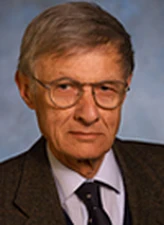Jean-Yves Parlange

The 2010 Alfred Wegener Medal & Honorary Membership is awarded to Jean-Yves Parlange for his fundamental contributions to improved understanding and description of the geophysical aspects of transport in soils, aquifers and other porous materials.
Jean-Yves Parlange was trained in civil and aeronautical engineering at France’s prestigious Ecole Nationale Supérieure de l’Aéronautique. In his Ph.D. research at Brown University he honed his deep understanding of fluid mechanics and thermodynamics in developing general principles governing the influence of different types of diffusion processes on laminar flows near flame interfaces. For this work he received the prestigious Minta Martin National Award by the Institute of Aerospace Sciences. Subsequently, after obtaining a tenured position in physical chemistry at Yale University, he gradually became interested in environmental physics and, more specifically, groundwater pollution, transport phenomena, water and solute movement in porous media, denitrification, surface and subsurface hydrology, watershed modelling, sediment transport and erosion.
His publication record includes over 500 refereed publications in prestigious journals such as Nature and Science, and in internationally leading discipline journals, e.g., Advances in Water Resources, Water Resources Research, Transport in Porous Media, Soil Science, Journal of Hydrology, Geoderma, ZAMP, and many others. His collaborators span the globe, and he has spent short visits and sabbaticals in France, the UK, Australia, Switzerland, the USA, Mexico and many others.
Parlange is renowned for his analytical skills in providing the mathematical and physical basis for deeper understanding of the behaviour of geophysical fluids in porous media. Some examples: “inventing” superposition in unsaturated porous media, developing analytical solutions for predicting erosion with colleagues in Australia and the UK, extending theory for wetting front instability in air-water and oil-water systems with graduate students at Cornell, developing infiltration equations with many different scientists around the world, advancing measuring techniques for soil water parameters and working on many other areas such as hillslope hydrology, fractals, surface seal development and solute transport. In particular, the following two achievements stand out by their innovation, originality, scholarship and lasting nature.
Parlange introduced a new fundamental approach to analyse water movement in soils by a double integration of Richards’ equation. This method now forms the basis for obtaining simple analytical solutions in practically all theoretical studies of unsaturated soil water flow conducted in hydrologic science. It involves no extra work, yet attains an accuracy superior to the earlier approaches that it made redundant. In particular, using this technique, Parlange and co-workers obtained explicit and practical equations to predict infiltration and drainage in terms of sorptivity, hydraulic conductivity, and air and water entry pressures. The double integration method was subsequently validated and confirmed by accurate numerical solutions and by exact analytical solutions obtained for certain simple and idealized problems.
More than 30 years ago, as a logical outgrowth of his earlier work on flame stability, Dr. Parlange recognized the importance of wetting front instability in sandy soils overlying primary aquifers, resulting in the now famous 1976 paper on the theory of calculating finger diameters. With the interest during the last 20 years in predicting the fast and early arrival of pesticides in groundwater, the 1976 theory has received much interest. Experiments carried out during the last ten years at Cornell and elsewhere confirmed the validity of the theory. In the mid-1980’s, Parlange developed, with his students, a theory to predict the moisture content structure in the finger. He also realized that hysteresis is a key phenomenon in the description of such instabilities. As a consequence, he developed a model for hysteresis based only on the knowledge of grain size distribution, conductivity and air entry potential, to yield all scanning curves of any order. The most recent research has led to adaptation of the unstable flow theory from air-water to oil-water systems. His findings have had major implications for the hydrodynamic control in cleaning up oil contaminated sites, secondary oil recovery in oil fields, minimizing pollution from mine spoils and finding ways to reduce pollution of agrochemicals.
Parlange’s many collaborators comment on his fine personality, great enthusiasm and inspiring expertise. Rarely is there a professor who is so well respected by his current and former graduate students. In the classroom, he has the uncanny ability to explain even the most complicated theoretical issues in simple language that is clear to a beginning postgraduate student. As a teacher, he is stimulating and brings the best out of his students. In many cases, after a first review of a student’s paper, he rewrites it, adds new theory, but always leaves the student who performed the initial research as first author.
A good way to judge the effectiveness as a teacher is to look at the quality of the graduate students.
As expected, many of Parlange’s graduate students are now (or will be) distinguished scientists, many of whom are still cooperating with him. The list includes: Robert Glass, John Selker, David Lockington, Graham Sander, Frank Stagnitti, William Sanford, Yih-Chi Tan, Nathan Bailey and Yaping Liu.
It is clear that Parlange’s superior contributions and his intense dedication to scholarship and teaching put him at the very top of our scientific profession. One can scarcely think of a more outstanding and deserving candidate for recognition by the EGU. He is a product of the French engineering tradition, who has gone on to influence the science of hydrology as practised across every continent. Equally important, he has throughout his career exemplified a true generosity in sharing his scientific gifts with a legion of collaborators. He is an internationally recognised scholar who is known for not only his science but for his truly kind and gentlemanly character.
Medal lecture video (Youtube) of the Alfred Wegener Medal given at the EGU General Assembly 2010.
